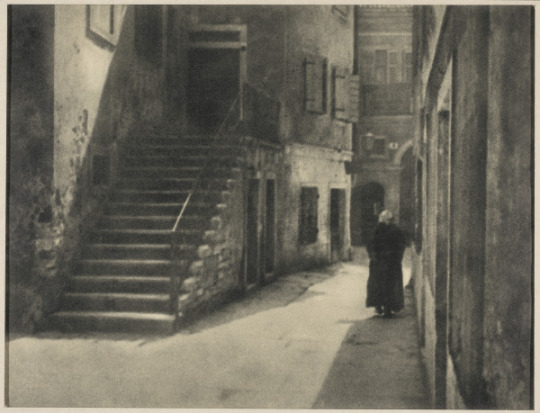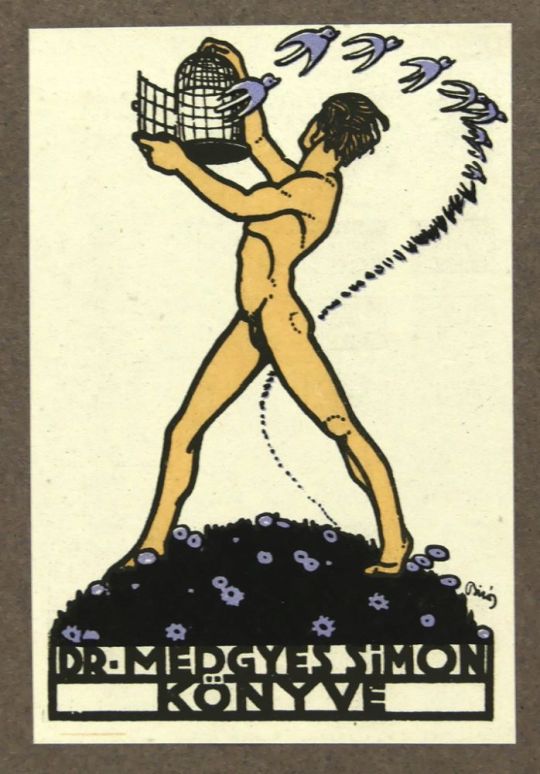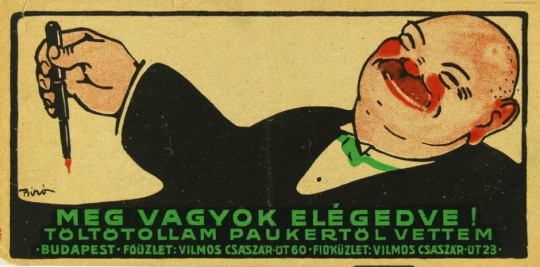#bíró
Explore tagged Tumblr posts
Photo

A Bánya, 1910. 38.
via EPA
10 notes
·
View notes
Text

Az egyik legnagyobb klasszikus!
103 notes
·
View notes
Text

Emeri Révész-Bíró (Hungarian, 1895 - 1975)
Hungary
1930
36 notes
·
View notes
Text
instagram
0 notes
Link
László József Bíró, Hispanicized as Ladislao José Biro, was a Hungarian-Argentine inventor who patented the first commercially successful modern ballpoint pen....
Link: László Bíró
0 notes
Text

The Last Command (1928)
Before their professional rupture while making The Blue Angel (1930), both Josef von Sternberg and Emil Jannings came from German-speaking environments to find success in Hollywood. But while von Sternberg’s family emigrated to the United States from Austria in his teenage years, Jannings carved out a reputation of playing larger-than-life protagonists in Universum-Film AG (UFA) films such as F.W. Murnau’s The Last Laugh (1924) and Faust (1926). His rising star spurred Paramount to offer Jannings a short-term contract that lasted two-and-a-half years and six features. Of Jannings’ extant movies at Paramount*, The Last Command is the one that has brought the most acclaim.
We open in 1928 Hollywood. While shooting a Russian Revolution picture, Russian expatriate director Leo Andreyev (an underutilized William Powell) selects Sergius Alexander (Jannings; whose character is living in poverty and takes jobs as a Hollywood extra) out of a heap of casting photos. Leo’s decision to cast Sergius is less magnanimous than it first appears to be, but to say more would be to spoil the ending. While in the dressing room, Sergius reminisces about events a decade prior. Flash back to 1917 Imperial Russia. Grand Duke Sergius Alexander, cousin of the Tsar, Commanding General of the Russian Armies (for students of Russian history and politics, this is analogous to “Chief of the General Staff”), is commanding the tsarist troops to battle Bolshevik revolutionaries. Informed that two actors entertaining his soldiers are actually Bolshevik agents, he orders that they be ushered into his office so that he might humiliate them. Sergius has his way with one of the agents, Leo Andreyev. But for Natalie Dabrova (Evelyn Brent), Sergius finds himself attracted to her. Despite the dangers involved, he keeps Natalie by his side. Revolutionary zeal and Stockholm syndrome be damned, they fall in love. The film will conclude when it flashes back to 1928 Hollywood.
Jack Raymond (later a director of films such as 1930’s The Great Game) plays a brief role as Leo’s conceited Assistant Director.
The circumstances and developments surrounding Sergius and Natalie’s romance is far-fetched and contrived beyond belief. Natalie’s reasons for falling for Sergius – paraphrasing her, that she could never believe that someone could love Russia as much as he – are unintentional comedic gold. The film’s best line appears as Sergius realizes that Natalie is not going to act on her revolutionary beliefs to assassinate him: “From now on you are my prisoner of war – and my prisoner of love.” All credit to intertitle writer Herman J. Mankiewicz (1941’s Citizen Kane, 1942’s The Pride of the Yankees) for that screamer of a line. Whatever political differences between the two main characters melts away because of that.
This writing from journeyman screenwriter John F. Goodrich (1933’s Deluge, 1936’s Crack-Up) and the story from Lajos Bíró (1933’s The Private Life of Henry VIII,1940’s The Thief of Bagdad) points to a larger problem regarding the film’s political depictions. Never mind the ideological chasm that exists between a man sworn to uphold the tsarist establishment and a woman to whom that very establishment is the embodiment of all that she and her comrades find loathsome. The Last Command, in keeping with Western attitudes towards the Bolsheviks, is decidedly sympathetic towards Imperial Russia, rather than the inebriated, murder-hungry proletariat mob that wants nothing but bloodshed. There is no political nuance to these depictions. Tsarist Russia is honorable, the unquestionably legitimate state; the Bolsheviks’ demands flattened to simply mindless violence for the sake of it. This is not to deny the facts that there were decent people serving the Tsar nor that the Bolsheviks engaged in excessive violence, but that the film overly simplifies the conditions in 1917 Russia.
Despite his status as one of the most accomplished Hollywood directors working during the transition from silent film to synchronized sound, Josef von Sternberg disdained the Studio System and producer control over filmmaking (if only he was alive to see how things are today!). In The Last Command’s bookending scenes in 1928 Hollywood, von Sternberg takes aim squarely at Hollywood norms. Note the arrogance in which the Assistant Director conducts himself in front of all the extras. How infuriating it must be for the audience when he chastises the elderly Sergius for correcting him about a detail on a Russian general’s uniform: “I’ve made twenty Russian pictures. You can’t tell me anything about Russia!” Filmmaking in this environment, according to The Last Command, is exploitative. There is little to no regard about the wellbeing of all the extras scraping by with a meager day’s wages. As for Leo’s intentions for Sergius, the psychological cruelty in which he directs him is something he may or may not come to regret in the film’s final seconds. In those closing shots, the Assistant Director’s pithy remark encapsulates Hollywood’s wanton disregard for those uncredited many who wove themselves into the magical fabric of Old Hollywood.
The film’s most narratively crucial scenes – excluding the romantic scenes between Sergius and Natalie – make excellent use of extras and the blocking of extras. Whether it is the scene where the Bolsheviks drag Sergius off the train and threaten to hang and mutilate him or the film’s final scene on the studio soundstage, there is a bustling of activity in the background. Von Sternberg and cinematographer Bert Glennon (1939’s Stagecoach and Drums Along the Mohawk) vivify The Last Command with these masses of people. Look at the furious, grasping hands as Sergius as the Bolsheviks tear his outer layers off in the cold – this might not approach the violence of Sergei Eisenstein’s Battleship Potemkin (1925), but that is because the anger here is directed at a solitary figure. The crew behind the camera and the extras reacting organically to Sergius’ acting adds to Jannings’ memorable performance in the climax, empowering a scene very obviously shot on a soundstage.
Somehow, these critical framing scenes from The Last Command escaped the attention of Paramount executives during the film’s production. When learning about them only after seeing the final product, they planned to prevent the film’s release. Also citing von Sternberg’s portrayal of the Russian Revolution (including portraits of Stalin and Trotsky), Paramount’s executives only relented when an unnamed Paramount stockholder compelled them to release The Last Command.
In spite of the questionable central romance and its poor historical representations, The Last Command thrives due to Jannings’ performance. Paramount wanted Jannings for this role due to his reputation as a theatrical, bombastic actor. He does not disappoint here. Taking a page from his performance in The Last Laugh, Jannings’ character similarly takes pride in an article of clothing. Where in The Last Laugh he loses his doorman’s uniform, Jannings regains a general’s uniform in The Last Command. With it, an utterly broken man finds a modicum of self-respect (at the very least), or perhaps it resurfaces the jingoist that once was. The physical transformation and mental turn Jannings embodies is absolutely compelling and deeply tragic. Art then begins to replicate the past too faithfully. Man and character become the same. Jannings won the inaugural Academy Award for Best Actor for The Last Command and The Way of All Flesh (1927)‡, despite German Shepherd Rin Tin Tin (1922’s The Man from Hell’s River, 1925’s The Clash of the Wolves) receiving the most votes in the category. The Academy of Motion Picture Arts and Sciences (AMPAS), wishing to be taken seriously and not wanting to bestow the inaugural Best Actor statue to a dog, gave the award to the runner-up, Jannings.
Back in Weimar Germany, Jannings and von Sternberg would work together on The Blue Angel (1930) – their finest collaboration with each other. But the two clashed repeatedly while making The Blue Angel, mostly over von Sternberg’s fawning over Marlene Dietrich during production. Von Sternberg returned to America and remained with Paramount until 1935, and his Hollywood standing rose alongside Marlene Dietrich's. Following the end of that contract, he bounced around various Hollywood studios, never again finding the cinematic footing he had while at Paramount. By contrast, Jannings remains in the German film industry following The Blue Angel and starred in several Nazi propaganda films that, after the end of World War II, made him unemployable.
As if foreshadowing Sunset Boulevard (1950), The Bad and the Beautiful (1952), and even Singin’ in the Rain (1952), this dramatic unpackaging of Hollywood’s dark underbelly has elements of scathing satire that form the backbone of the its best moments. No matter the mutual accusations of imperiousness, Jannings and von Sternberg while on set of The Last Command, pieced together a film that obscures its true messaging beneath its ridiculous romance.
My rating: 8.5/10
^ Based on my personal imdb rating. My interpretation of that ratings system can be found in the “Ratings system” page on my blog. Half-points are always rounded down.
* The Way of All Flesh (1927), The Patriot (1928), and Street of Sin (1928) are lost; Sins of the Fathers (1928) is only rumored to be intact; and only The Last Command and Betrayal (1929) are extant.
‡ The 1st Academy Awards was the only ceremony in which actors and actresses were nominated for a body of work, rather than their work on an individual film.
For more of my reviews tagged “My Movie Odyssey”, check out the tag of the same name on my blog.
#The Last Command#Josef von Sternberg#Emil Jannings#Evelyn Brent#William Powell#Jack Raymond#Nicholas Soussanin#Michael Visaroff#Fritz Feld#Lajos Bíró#John F. Goodrich#Herman J. Mankiewicz#Bert Glennon#William Shea#silent film#TCM#saveTCM#My Movie Odyssey
0 notes
Text
Egy éve világítottak az Árpád-hídon először a Dunavirágzás ideje alatt az ún kérészvédő sorompók. A Dunavirág a Duna endemikus kérészfaja, amely sokáig eltűnt a Duna magyar szakaszáról, lévén igen érzékeny a víz szennyezettségére. A szennyvíztisztítás magas fokozatainak kiépülésével és a nehéz-, illetve a vegyi ipar elsorvadásával együtt a Duna tisztulni kezdett, s ma már sokkal nagyobb bátorsággal lehetne benne nyílt vízi úszóversenyt szervezni, mint a Szajnában. A kérészek visszatértek, de “dunavirágéletűek”, rajzásukkor az utódnemzés sikeressége azon múlik, hogy a folyóba halnak-e bele a násztáncuk után, vagy a hidakon, aszfalton végzik. A víz feletti kompenzációs repülésüket a hidak és azok közúti világítása sajnos eltéríti. Az Árpád-hídon a korábbi rajzásokkor tömegével pusztultak el a Dunavirágok, s velük együtt a megtermékenyített petéik, azaz a következő nemzedék is. Kriska György és csapata egy olyan kék fényű terelőfényt fejlesztett ki, amely képes a víz fölött tartani a kérészeket, így megmenekülnek a peték. Ezt először Tahiban, a Tildy Zoltán hídon alkalmazták.
Budapesten a Tájépítészeti osztály Természetvédelmi csoportja készítette elő velük, a Budapest Közúttal és a BDK-val, valamint a vízi rendőrséggel együttműködve a kék fények kihelyezését az Árpád-híd pilléreire. Tavaly nem volt látványos a rajzás, mert az esős idő és a folyó magas vízállása nem kedvezett a tömeges virágzásnak. Idén azonban a napokban esténként csodálatosan virágzik a Duna. A kérészek védett állatok, ezért aki megszemlélné a virágzásukat, az tartsa magát a “mindent a szemnek, semmit a kéznek” elvhez.
---
Augusztus 23-án a kérészvédő fénysorompó kék fényei várakozásainknak megfelelően kiválóan működtek az Árpád hídnál. A rajzás fő szakaszában 9 órától 10 óra 20 percig óriási kérészcsóva alakult ki a kék lámpáknál, amely a vízfelszínt is elérte, így a kék fények által vonzott dunavirág nőstények le tudták rakni petéiket a folyóba, nem pusztultak el az Árpád híd száraz aszfaltútján. A védőfények milliónyi kérészt mentettek meg. Ha csak 1 millióval számolunk, akkor is 10 milliárd forintnyi természetvédelmi kárt sikerült elkerülni azzal, hogy az egyenként 10 ezer Ft-os természetvédelmi értékkel bíró állatok nem repültek fel a hídra. Itt szeretném megjegyezni, hogy kollégáimmal, a HUN-REN Ökológiai Kutatóközpont és az ELTE TTK munkatársaival fejlesztettük ki a kérészvédő fénysorompó prototípusát, amely az egész világon egyedül két helyen, Tahitótfalun a Tildy Zoltán hídon és Budapesten az Árpád hídon működik. Tehát egy igazi hungarikumról van szó! A felvételeket Kriska Ferenc készítette.




fb
161 notes
·
View notes
Text
Chilifőző verseny
Egyik kedvenc történetem:
Nemrégiben abban a megtiszteltetésben részesültem, hogy bírónak választottak ki egy chilifőző versenyen. Az eredeti bíró megbetegedett, az utolsó pillanatban én pedig pont ott álltam a bírói asztalnál és a sörös sátor holléte felől érdeklődtem, mikor felkértek. A másik két bíró (két indiai) biztosított róla, hogy a chili egyáltalán nem lesz erős, azonkívül ingyen sört kapok a kóstolgatás teljes idejére, tehát belementem. Íme az értékelő lapok a versenyről:
Chili #1: Manoj Maniac Mobster-Monster Chili-je
1. BÍRÓ: Kicsit túl sok paradicsom. Nagyszerű zamat.
2. BÍRÓ: Kellemes, sima paradicsom íz. Nagyon enyhe.
3. BÍRÓ: Jesszusom, mi a pokol volt ez? Ezzel le lehetne szedni a megszáradt festéket az úttestről. Két sörbe került, hogy kioltsam a lángokat. Remélem ez volt a legrosszabb.
Chili #2: Applesamy Utánégető Chili-je
1. BÍRÓ: Füstös, enyhe sertés beütéssel. Gyengén csípős Jalapeno íz.
2. BÍRÓ: Izgalmas sült rostélyos íz, több paprika kellene bele, hogy komolyan lehessen venni.
3. BÍRÓ: Gyermekektől távol tartandó! Nem vagyok benne biztos, hogy mit kellene éreznem a fájdalmon kívül. El kellett zavarnom két fickót, akik Heimlich-fogást akartak alkalmazni rajtam. Sürgősen több sört kellett hozniuk mikor meglátták az arcomon a grimaszt.
Chili #3: Farouk Híres Gyújtsd Fel Az Istállót Chili-je
1. BÍRÓ: Kiváló, tüzes chili! Nagyszerű zamat. Több bab kellene bele.
2. BÍRÓ: Bab nélküli chili, kissé sós, remekül használja a piros paprikát.
3. BÍRÓ: Hívjatok szakembert, felfedeztem egy urániumszivárgást! Az orromban olyan érzésem van, mintha Domestos-t szipákoltam volna.Már mindenki tudja mi a dolga, hozzák a söröket, mielőtt meggyulladok. A pincérkislány hátba vágott, így most a gerincem a mellkasom első részében van. Az ábrázatom kezd igen ramatyul kinézni a sok sör miatt.
Chili #4: Barbu Fekete Mágiája
1. BÍRÓ: Fekete bab chili gyakorlatilag bármi fűszer nélkül. Kiábrándító...
2. BÍRÓ: Enyhe hárs íz a fekete babhoz. Köretként használható halhoz vagy egyéb enyhe ételekhez, nem igazan lehet chili-nek nevezni.
3. BÍRÓ: Éreztem, hogy valami a nyelvemhez dörgölőzik, de az ízét nem éreztem, lehetséges az ízlelőbimbókat kiégetni? A pincérkislány mögöttem állt a friss sör utánpótlással; az a 150 kilós lotyó egyre izgibbnek néz ki. Ez a nukleáris hulladék, amit eszem szintén. Nem lehet, hogy a chili fokozza a nemi vágyat?
Chili #5: Laveshnee Legális Ajak-Eltávolítója
1. BÍRÓ: Húsos, erős chili. A frissen őrölt Cayenne bors tökéletes ízt ad. Igazán nagyszerű.
2. BÍRÓ: Chili aprított sztékkel. Több paradicsomot még elbírna. El kell ismerni, a cayenne bors igen erős benyomást tesz.
3. BÍRÓ: A füleim csengenek, a homlokomon izzadtság folyik és a szemeimmel már nem tudok fókuszálni. Elfingottam magam, négy ember mögöttem kórházi kezelésre szorul. A versenyző megsértődött, mikor megmondtam neki, hogy a chili-je következtében agykárosodást szenvedtem. A pincérlány megmentette a nyelvemet a vérzéstől azzal, hogy egy kancsóból sört öntött közvetlenül a nyelvemre. Azon gondolkozom, vajon le fogom-e égetni az ajkaimat. Nagyon idegesít, hogy a másik két bíró folyton megkér, fejezzem be a sikoltozást.
Chili #6: Vera Világi Vegetáriánus Variációja
1. BÍRÓ: Híg, de mégis erős vegetáriánus chili. Jól eltalált egyensúly a különféle erős paprikák között.
2. BÍRÓ: Az eddigi legjobb. Agresszívan használ erős paprikát, hagymát és fokhagymát. Igazán nagyszerű.
3. BÍRÓ: A beleim immár egyenes csövek gáz állapotú, kénes lánggal megtöltve. Összecsináltam magam, mikor fingottam és attól félek, hamarosan átégeti a széket. Úgy tűnik senki nem tud megmaradni mögöttem, kivéve a pincérlányt, azt hiszem perverzebb, mint gondoltam. Már nem érzem az ajkaimat. Kéne egy nagy fagyi, hogy kitörölhessem a fenekem vele.
Chili #7: Sugash Sikító Szenzáció Chili-je
1. BÍRÓ: Közepes chili, túl sok konzerv-paprikát használ.
2. BÍRÓ: Hát, hát. Olyan az íze, mintha gyakorlatilag az utolsó pillanatban beledobtak volna egy konzervnyi paprikát. Meg kell jegyezzem, aggályaim vannak a 3-as számú bíróval kapcsolatban. Úgy tűnik egy kissé csalódott, mivel folyamatosan durván káromkodik.
3. BÍRÓ: Valaki tehetne egy gránátot a számba, kihúzhatná a biztosítótűt, és én az égvilágon semmit sem éreznék. Az egyik szememre megvakultam, és a külvilágnak olyan hangja van, mintha minden rohanó vízből állna. Az ingemet teljesen beborítja a chili, ami észrevétlenül kicsusszant a szám szélén. A gatyám tele van, így legalább passzol az ingemhez. Legalább majd a boncolás során tudni fogják, mi okozta a halálomat. Úgy döntöttem abbahagyom a lélegzést, mivel túl fájdalmas. Francba vele, oxigénhez úgysem jutok. Ha levegőre lesz szükségem, majd szippantok a hasamon lévő 10 centis lyukon keresztül.
Chili #8: Hansraj Hegyi Szent Chili-je
1. BÍRÓ: Tökéletes befejezés, ez egy jó ízű chili, mindenki számára biztonságos, nem túl erős, de pont elég fűszeres ahhoz, hogy észrevetesse magát.
2. BÍRÓ: Ez az utolsó darab egy jó, kiegyensúlyozott chili, nem túl erős és nem is túl enyhe. Sajnálattal láttam, hogy nagy része kárba veszett mikor a 3-as számú bíró elájult, leesett a székről és magára rántotta a chilistálat. Nem biztos, hogy túléli. Kíváncsi lennék, mit szólt volna egy igazán csípős chilihez?
3. BÍRÓ: Nincs feljegyzés...
201 notes
·
View notes
Text
legshadybb küzdősport a box btw

a másik sportoló nevét nem sikerült leírni a címben
15 notes
·
View notes
Text

A foci szabályok gyerekkorunkban.
1. - Mindig a dagi volt a kapus
2. - A játék akkor ért véget, amikor mindenki fáradt volt
3. - Még ha 20-0 is volt az állás, aki utoljára gólt lőtt,az nyert.
4. - Nincs bíró.
5. - Csak akkor volt szabálytalanság, ha egyértelmű volt, vagy valaki elkezdett sírni.
6. - Nem volt olyan, hogy offside
7. - Ha a labda tulajdonosa megharagudott, vége lett a meccsnek.
8. - A két legjobb játékos nem lehetett egy csapatban, és ezt ők is tudták.
9. - Ha téged választottak utoljára, az nagy megaláztatás volt, azt jelentette, hogy senki sem akart téged.
10. - 2-3 órát is játszottál egymás után.
11. - A meccset leállították, amikor egy idős férfi elhaladt mellette
12. - A szomszéd játékosok örökké ellenségek voltak.
13. - Akinek fogalma sem volt a fociról, az tartalékos, vagy maximum védők maradhattak.
14. - Amikor a nagyok játszottak, tiltakozás nélkül kellett elhagyni a pályát.
15. -Mindig volt egy szomszéd, aki nem engedett játszani, és megfenyegetett, hogy el fogja venni a labdát.
16. - Ha volt fogadás, a játék nagyon komoly volt, mintha döntő lenne.
17. - Két kö vagy két dzseki volt a kapufa.
18. - Amikor a kapust lökték, érvénytelen volt a gól.
19. - A szabályokat még a meccs elkezdődése előtt állapították meg.
92 notes
·
View notes
Text
1 note
·
View note
Text
*nem is vagyok annyira akaratos és makacs*
Én a bíróságon: bíró úr, maradjon már csendben, honnan tudná, hát ott sem volt
55 notes
·
View notes
Text








The Hungarian Christines
- Bíró Eszter
- Király Linda
- Krassy Renáta
- Mahó Andrea
- Fonyó Barbara
- Haraszti Elvira
- Jenes Kitti
- Széles Flóra
Photos: Madách Színház - Az Operaház Fantomja online programme
#phantom of the opera#phantomoftheopera#az operahaz fantomja#az operaház fantomja#poto hungary#poto Budapest#eszter biró#linda király#Renata Krassy#Andrea mahó#Barbara Fonyó#Elvira Haraszti#Kitti Jenes#Flóra Széles
49 notes
·
View notes
Text
"Sajnos az az igazságszolgáltatás, melynek igyekeztem elkötelezett képviselője lenni, mára megszűnt létezni. Más választásom nem lévén, a mai napon a bírói tisztségről lemondtam. Meg nem hajol, meg nem rogy, meg nem törik"
EMBER!
20 notes
·
View notes




